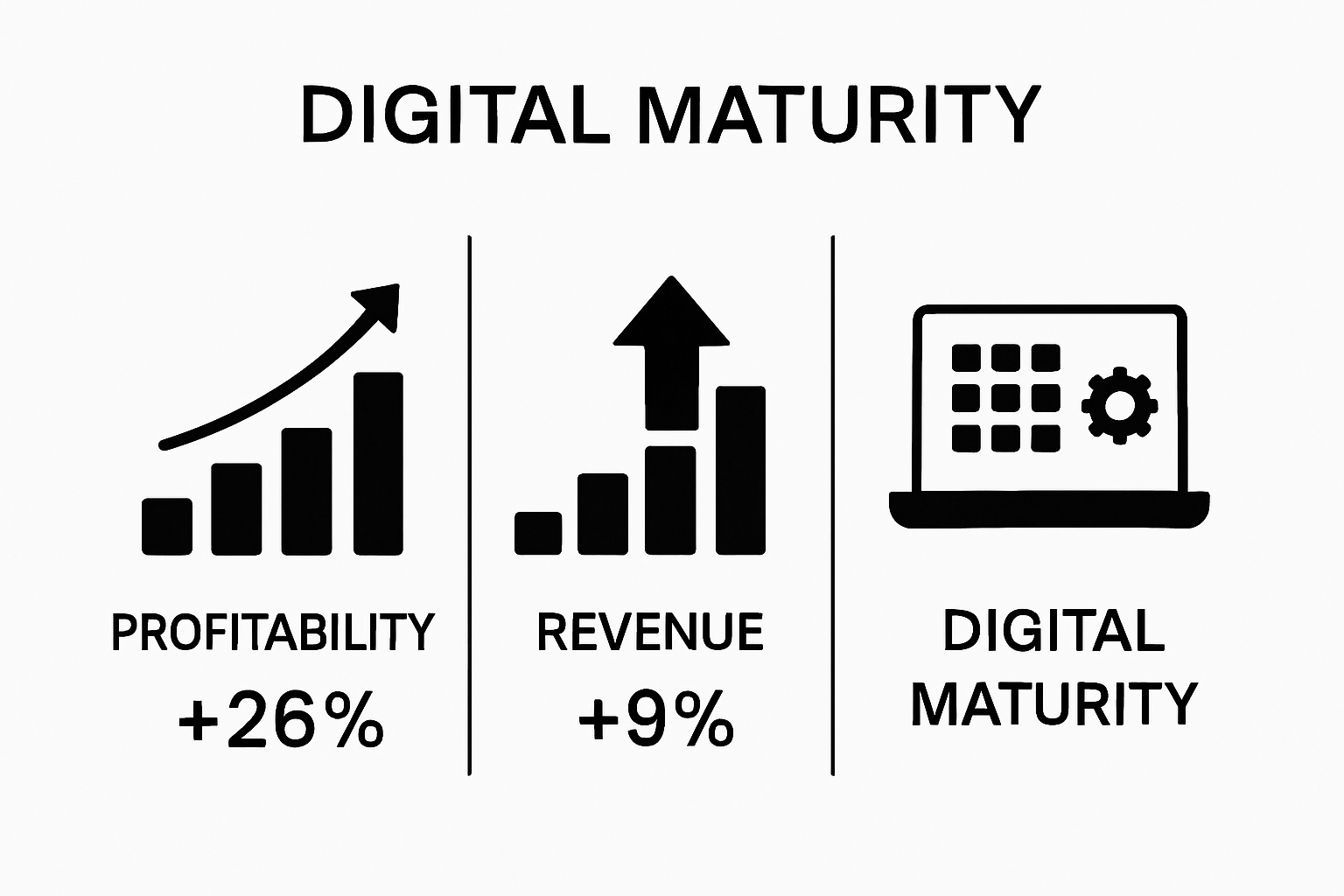Every business talks about going digital, but the true meaning of digital transformation often gets lost in the buzz. Most people think it just means upgrading your tech stack. Yet, the real secret is that companies who get it right are seeing some wild results. Businesses that embrace digital transformation are 26 percent more profitable and pull in 9 percent higher revenue from their assets compared to their competitors. These numbers are turning the old rules upside down, and the debate is no longer about if digital transformation matters, but how it completely reshapes the way companies win or lose.
Table of Contents
- What Is Digital Transformation In Business?
- Why Digital Transformation Matters For Businesses
- How Digital Transformation Works: Key Components
- Real-World Applications Of Digital Transformation
- Challenges And Considerations In Digital Transformation
Quick Summary
| Takeaway | Explanation |
|---|---|
| Digital transformation is essential for survival | Companies must integrate digital technologies to stay relevant in a competitive market. |
| Focus on customer experience enhancement | Businesses should redesign customer engagement strategies through digital platforms for better satisfaction. |
| Build organizational agility and resilience | Prioritize flexible structures and continuous learning to adapt to market changes effectively. |
| Leverage data analytics for decision-making | Utilize data-driven insights to improve operational efficiency and strategic planning across the organization. |
| Address cultural challenges during transformation | Cultivating a digital-ready culture is crucial for overcoming resistance and ensuring successful technology integration. |
What is Digital Transformation in Business?
Digital transformation represents a fundamental reimagining of how businesses operate and deliver value in the digital age. At its core, this process involves integrating advanced digital technologies into every aspect of organizational strategy, fundamentally changing how companies interact with customers, manage internal processes, and create competitive advantages.
Defining the Digital Transformation Concept
Digital transformation goes beyond simply implementing new technologies. According to research from MIT Sloan Management Review, it is a comprehensive strategic approach that fundamentally restructures business models, operational processes, and organizational culture. This means reimagining traditional workflows, customer engagement strategies, and product development methodologies through a digital lens.
Key aspects of digital transformation include:
- Leveraging data analytics to drive decision making
- Redesigning customer experiences through digital platforms
- Automating complex business processes
- Creating more agile and responsive organizational structures
Why Digital Transformation Matters
Businesses are increasingly recognizing that digital transformation is no longer optional but essential for survival. Companies that successfully implement digital strategies can expect significant benefits. Our guide on digital document transformation provides deeper insights into how technological integration can revolutionize business operations.
The primary drivers of digital transformation include:
- Increasing competitive pressure from digital native companies
- Rising customer expectations for seamless digital experiences
- Need for operational efficiency and cost reduction
- Opportunities to develop innovative revenue streams
By embracing digital transformation, organizations can create more responsive, intelligent, and customer centric business models that are prepared for the rapidly evolving technological landscape.
Why Digital Transformation Matters for Businesses
In an increasingly competitive and technology-driven business environment, digital transformation has become more than a trendy buzzword. It represents a critical strategic imperative for organizations seeking to remain relevant, competitive, and responsive to rapidly changing market dynamics.
The Competitive Landscape Shift
Businesses today operate in a digital ecosystem where technological adaptation determines survival. According to research from Deloitte, companies that successfully implement digital transformation strategies are 26% more profitable and generate 9% higher revenue from physical assets compared to their less digitally mature counterparts.

Key competitive advantages include:
- Faster response to market changes
- Enhanced customer engagement capabilities
- More efficient operational processes
- Improved data driven decision making
Strategic Business Resilience
Digital transformation is not just about technological upgrades but building organizational resilience. Our guide on digital document transformation highlights how technological integration can create more adaptable business models.
Businesses that prioritize digital transformation can:
- Reduce operational costs through automation
- Create new revenue streams
- Improve customer experience and satisfaction
- Develop more agile organizational structures
By investing in digital capabilities, companies can future proof their operations, anticipate market shifts, and maintain a competitive edge in an increasingly digital world. The transformation journey requires commitment, strategic planning, and a willingness to reimagine traditional business approaches.
How Digital Transformation Works: Key Components
Digital transformation represents a complex, multifaceted process that requires strategic planning, technological integration, and organizational cultural change. Understanding its key components helps businesses navigate this critical transition effectively.
Technological Infrastructure and Integration
At the foundation of digital transformation lies robust technological infrastructure. According to research from the OECD, successful digital transformation demands comprehensive technological integration across multiple organizational domains.
Key technological components include:
- Cloud computing platforms
- Advanced data analytics systems
- Artificial intelligence and machine learning capabilities
- Secure digital communication networks
Organizational and Cultural Adaptation
Transformation extends beyond technological implementation. Digital project management strategies emphasize the critical role of organizational culture in driving successful digital initiatives.
Cultural transformation elements involve:
- Developing digital literacy across all organizational levels
- Encouraging innovation and experimentation
- Creating flexible, collaborative work environments
- Promoting continuous learning and skill development
By understanding and strategically implementing these key components, businesses can create a comprehensive digital transformation approach that goes beyond mere technological upgrades. The process requires holistic thinking, persistent effort, and a commitment to ongoing innovation and adaptation.
Real-World Applications of Digital Transformation
Digital transformation transcends theoretical concepts, manifesting in concrete strategies across diverse industries. Organizations worldwide are leveraging technological innovations to reimagine business processes, customer experiences, and operational models.
The following table summarizes how digital transformation manifests in key industries, highlighting sector-specific strategies discussed in the content:
| Industry | Example Digital Transformation Strategy | Resulting Benefits |
|---|---|---|
| Healthcare | Telemedicine platforms and AI diagnostic tools | Improved patient access and diagnostic speed |
| Retail | Personalized online shopping experiences | Enhanced customer engagement and loyalty |
| Manufacturing | IoT enabled smart factories | Increased automation and operational efficiency |
| Financial Services | Mobile banking and blockchain technologies | Faster, more secure transactions and services |
Industry-Specific Digital Transformation Strategies
Different sectors demonstrate unique approaches to digital transformation. According to research from the United Nations Development Programme, digital initiatives can fundamentally reshape entire operational ecosystems.
Industry examples include:
- Healthcare: Telemedicine platforms and AI diagnostic tools
- Retail: Personalized online shopping experiences
- Manufacturing: IoT enabled smart factories
- Financial Services: Mobile banking and blockchain technologies
Practical Implementation and Workflow Optimization
Transforming business processes requires strategic technological integration. Our guide on automating business processes with Adobe PDF solutions demonstrates how targeted digital tools can streamline complex workflows.
Key practical implementation strategies involve:
- Identifying manual, repetitive processes for automation
- Implementing cloud based collaboration platforms
- Developing data driven decision making frameworks
- Creating seamless cross departmental digital communication channels
By embracing digital transformation, organizations can unlock unprecedented efficiency, innovation, and competitive advantage across multiple operational domains.
Challenges and Considerations in Digital Transformation
Digital transformation is not a simple linear process but a complex journey fraught with multifaceted challenges that require strategic planning, organizational commitment, and continuous adaptation. Understanding these potential obstacles is crucial for successful implementation.
The table below compares the organizational and technological challenges businesses face during digital transformation, helping readers distinguish between these two critical areas:
| Challenge Category | Examples from Article | Impact on Transformation |
|---|---|---|
| Technological Barriers | Legacy system incompatibility, insufficient infrastructure, high costs, data migration, cybersecurity vulnerabilities | Hinder implementation of new technologies and slow progress |
| Organizational/Cultural Barriers | Resistance to change, skills gaps, need for continuous learning, restructuring, aligning initiatives to goals | Lead to employee pushback and misalignment with business strategy |
Technological and Infrastructural Barriers
Technological readiness represents a significant hurdle for many organizations. According to research analyzing digital transformation challenges, companies often struggle with integrating new technologies into existing systems.
Key technological challenges include:
- Legacy system incompatibility
- Insufficient digital infrastructure
- High implementation and maintenance costs
- Complex data migration processes
- Cybersecurity vulnerabilities
Organizational and Cultural Transformation
Beyond technological considerations, digital transformation demands profound cultural shifts. Our guide on digital document transformation highlights the importance of addressing human factors during technological transitions.
Organizational transformation obstacles involve:
- Resistance to change from employees
- Skills and talent gaps
- Need for continuous learning programs
- Redesigning traditional hierarchical structures
- Aligning digital initiatives with strategic business goals
Successful digital transformation requires a holistic approach that balances technological innovation with human adaptability, organizational agility, and strategic vision. Companies must view this process as an ongoing journey of continuous learning and improvement.
Ready to Overcome Digital Transformation Challenges?
Making digital transformation work in your business can feel overwhelming. As highlighted in our article, integrating new systems, managing digital documents, and facing cultural resistance slow down innovation and drain productivity. When you need reliable solutions for digital preservation and efficient document workflows, finding proven tools is critical. See how digital leaders solve these challenges here: Digital Preservation

Transform obstacles into results with powerful software designed for real-world business needs. At Mapsoft.com, our expert team provides custom PDF tools, workflow automation, and enterprise-level support to help you move beyond manual hurdles. Put your business at the forefront of digital transformation today. Visit our site to discover your path to seamless integration and sustained success.
Frequently Asked Questions
What is digital transformation in business?
Digital transformation in business refers to integrating advanced digital technologies into all aspects of an organization’s strategy, reshaping how companies operate, engage with customers, and create competitive advantages.
Why is digital transformation important for businesses?
Digital transformation is crucial for businesses as it enables them to stay relevant and competitive in a technology-driven market. It leads to operational efficiency, better customer experiences, and new revenue streams.
What are the key components of digital transformation?
Key components of digital transformation include robust technological infrastructure, organizational and cultural adaptation, data analytics systems, and automation of business processes to enhance agility and responsiveness.
What challenges does digital transformation face?
Challenges in digital transformation can include technological barriers such as legacy system incompatibility, insufficient infrastructure, and cultural resistance from employees. Effective change management is crucial to overcoming these obstacles.
Recommended
- Understanding Digital Document Transformation for Businesses –
- Thriving Through Adapting to New Technologies
- Blog –
- Digital Project Management in 2025: Adobe-Powered Strategies –
Conclusion
Understanding digital transformation in business is crucial for companies looking to thrive in today’s digital landscape. By recognizing the impact of digital transformation in business, organizations can better position themselves for success.



